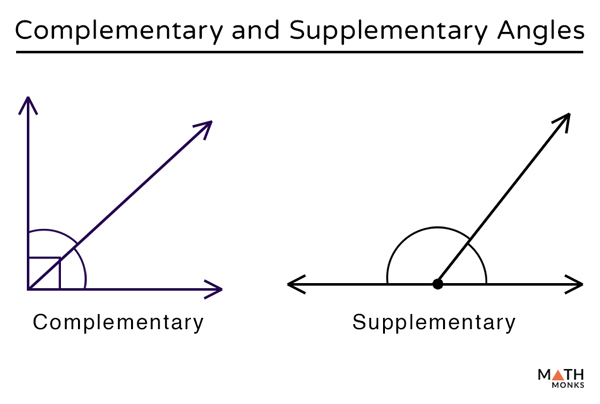

Splashlearn’s vision is to transform education for K-5th grade students.

#SUPPLEMENTARY ANGLE PICTURES HOW TO#
How to Construct an Angle (using protractor)

Engineers construct buildings, bridges, houses, monuments, etc., using angle measurement.Here, ∠AXD and ∠CXD are supplementary angles. Supplementary angles: Angles that add up to 180° (a straight angle) are called supplementary angles. Here, ∠BXC and ∠CXD are complementary angles. Complementary and Supplementary Angles:Ĭomplementary angles: Angles that add up to 90° (a right angle) are called complementary angles. Here, ∠ABC, ∠BCA and ∠CAB are interior angles.Įxterior angles: Exterior angles are the angles formed outside a shape, between any side of a shape and an extended adjacent side. Interior angles: Interior Angles are the angles formed within or inside a shape. A reflex angle measures between 180°- 360°.An angle measuring exactly 180° is a straight angle.A right angle precisely measures 90° at the vertex.An obtuse angle is between 90° and 180°.An acute angle measures less than 90° at the vertex.In the given diagram below, OA is the terminal side.īased on their measurements, here are the different types of angles: Terminal Side: The side up to which the angle measurement is done.Initial Side: Also known as the reference line, a straight line from where an angle is drawn.Arms: The two sides of the angle, joined at a common endpoint.Vertex: A vertex is a corner of an angle, a point where two lines/sides meet.Angles are measured in degrees (°) using a protractor.įor example, 45 degrees is represented as 45° Parts of Angles There are many daily life examples of an angle, such as cloth-hangers, arrowheads, scissors, partly opened doors, pyramids, edge of a table, edge of a ruler, etc. The word angle comes from a Latin word named ‘angulus,’ meaning “corner.” The common point of contact is called the vertex of an angle. Raw data is often discarded.An angle is formed when two straight lines or rays meet at a common endpoint. The images and processed data are stored on a PACS or other archival system. This can be done on the main scanner console or on a separate workstation.ġ0.
Additional post-processing is required for a number of advanced sequences, including MR angiography, vascular and CSF flow studies, cardiac imaging, diffusion tensor imaging, functional MRI, and spectroscopy. Hooray! Steps 6 through 8 are then repeated until all sequences in the protocol have been run.ĩ. Finally, the desired pulse sequence is run and the images are produced. These prescan steps are described more completely in subsequent Q&A's.Ĩ.
#SUPPLEMENTARY ANGLE PICTURES MANUAL#
Although a fully automated process, manual adjustments are also sometimes needed. Prescan consists of 6 steps: quick higher-order shimming, coil tuning/matching, center frequency calibration, transmitter gain adjustment, receiver gain adjustment, and dummy cycle stimulation. The scanner first goes through a brief (10-20 sec) calibration procedure known as prescan.


 0 kommentar(er)
0 kommentar(er)
